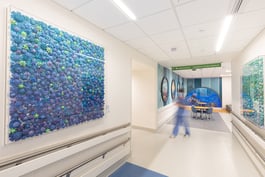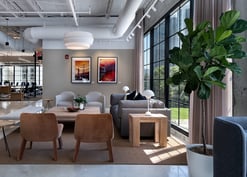The modern workplace is undergoing a fundamental transformation. Amid rapid technological advances and shifting cultural values, organizations are rethinking how they design office environments. Today’s work culture emphasizes adaptability, flexibility, and employee well-being: values that align with a broader cultural shift.
Alongside this evolving landscape, Generation Z’s entry into the workforce highlights and accelerates the growing demand for human-centric practices and supportive workplace infrastructure (Pataki-Bittó & Kapusy, 2021). Gen Z places a high value on results-driven work, clear communication, and inclusive, adaptable settings that align with personal and organizational values. To attract and retain this new wave of talent, businesses are adopting cultural and physical changes, embracing modern technology, personalized workspaces, and a deeper commitment to diversity, creativity, and innovation (Arno, 2024). 
Reimagining the Workplace
Understanding and retaining the next generation of workers requires a thoughtful reimagining of the workplace that supports mental health, adaptability, and emotional well-being.
Better support for mental health in the workplace leads to lower absenteeism rates, decreased healthcare costs, and enhanced employee adaptability and innovativeness. The World Health Organization suggests that salutogenic design strategies can address work-related mental health concerns, such as stress, sleep quality, mood, fatigue, depression, burnout, and general well-being, collectively and holistically (Kropman et al., 2023).
A 2021 study by Forooaghi et al. identifies three key dimensions that support employee engagement with their physical environment:
- Comprehensibility: Making spaces physically and psychologically intuitive through clear wayfinding and user involvement.
- Manageability: Giving employees a sense of control through visual variety, user-driven design, and wellness resources like private spaces or mindfulness tools.
- Meaningfulness: Cultivating environments that feel emotionally resonant, through culture, color, nature, and artwork.
Workplace design interventions that increase employee satisfaction such as open layouts, modular furniture, spaces for both collaboration and privacy, and visually stimulating environments have been shown to result in higher levels of productivity (Kropman et al., 2023), and for many Gen Z employees, spaces that blend creative inspiration with functionality are essential, making these changes a strategic investment for businesses (Ramadorai, 2023). 
How Art Can Promote Workplace Values
As the workforce places increasing value on authenticity, purpose, and inclusivity, art emerges as a powerful component of a more holistic office experience (Fayard et al., 2021).
Engaging with art has been linked to improved mood, stronger social connections, and enhanced cognitive performance (Ozbay et al., 2024). Neuroaesthetic studies show that viewing art can activate the nervous system and areas of the brain in ways that reduce cortisol levels, improve decision making, and enhance emotional regulation (Barnet & Vasiu, 2024). These responses have also been linked to improved memory, attention, and overall wellness (Rosier, 2010).
In hybrid work settings, where feelings of isolation, disconnection, and burnout may be prevalent, interventions prioritizing engagement and well-being are especially valuable. For example, unstructured, spontaneous interactions such as cross-departmental conversations and collaboration can promote empathy, social connectedness, and innovation through the exchange of ideas. While these interactions can’t be forced, office design can subtly encourage them (Fayard et al., 2021).
Thoughtfully designed environments that include access to visual art can spark moments of reflection and emotional connection. Art engages the same neural pathways we use to understand others, strengthening perspective-taking, emotional recognition, and interpersonal understanding. In the workplace, incorporating artwork into shared spaces can help subtly reinforce a culture of empathy, curiosity, and collaboration (Ozbay et al., 2024).
Today’s work culture is dynamic, fluid, and increasingly focused on the full employee experience. By investing in wellness-oriented, visually engaging environments, organizations not only adapt to post-pandemic realities but also cultivate workplaces that people genuinely want to be a part of. These investments center the human experience and promote adaptability, ensuring the future of the workplace is resilient and contemporary.
How TurningArt Can Help
At TurningArt, we believe that art in the workplace is more than an aesthetic choice; it’s a strategic investment in culture, connection, and well-being. Our curated visual art programs are designed to reflect organizational values, spark creativity, and support mental health in environments where people work, collaborate, and grow.
Whether it’s rotating collections that keep spaces dynamic, site-specific commissions that reinforce brand identity, or thoughtfully selected pieces that promote reflection and focus, TurningArt helps businesses create inspired, human-centered workplaces.
Connect with an Art Advisor below to learn more!

.jpg?width=332&height=177&name=_MG_0840%20copy%20(2).jpg)


.jpg?width=332&height=177&name=dtBv_067_DSC_2139_DaNil%20(2).jpg)


